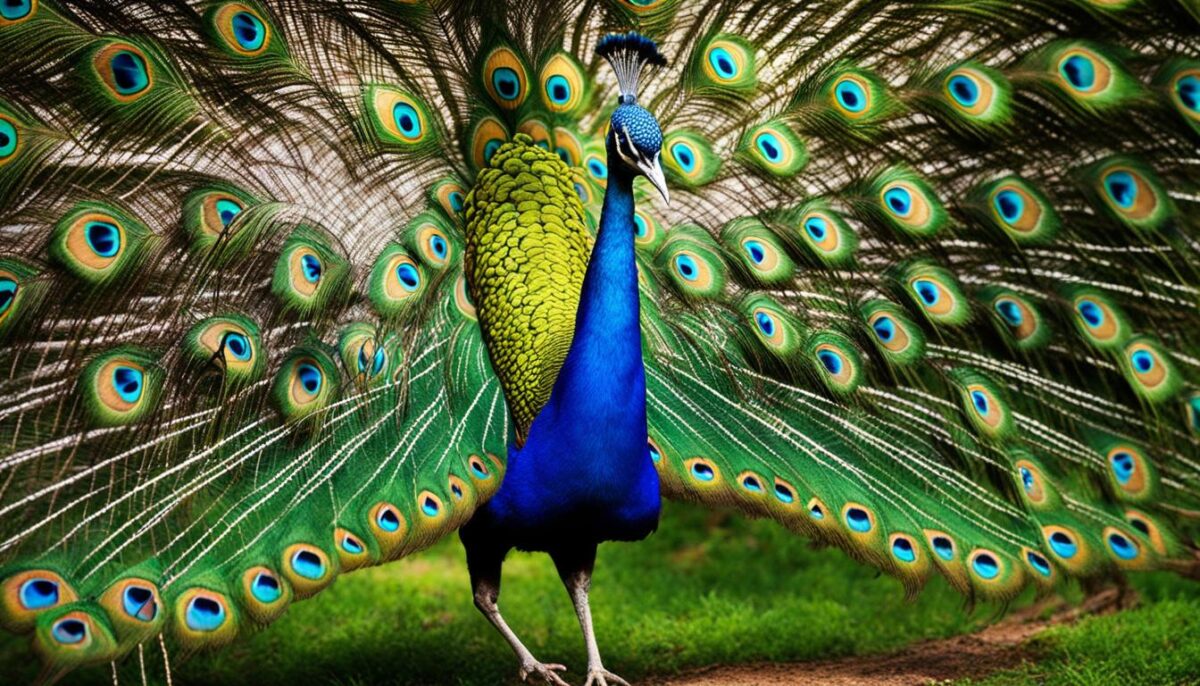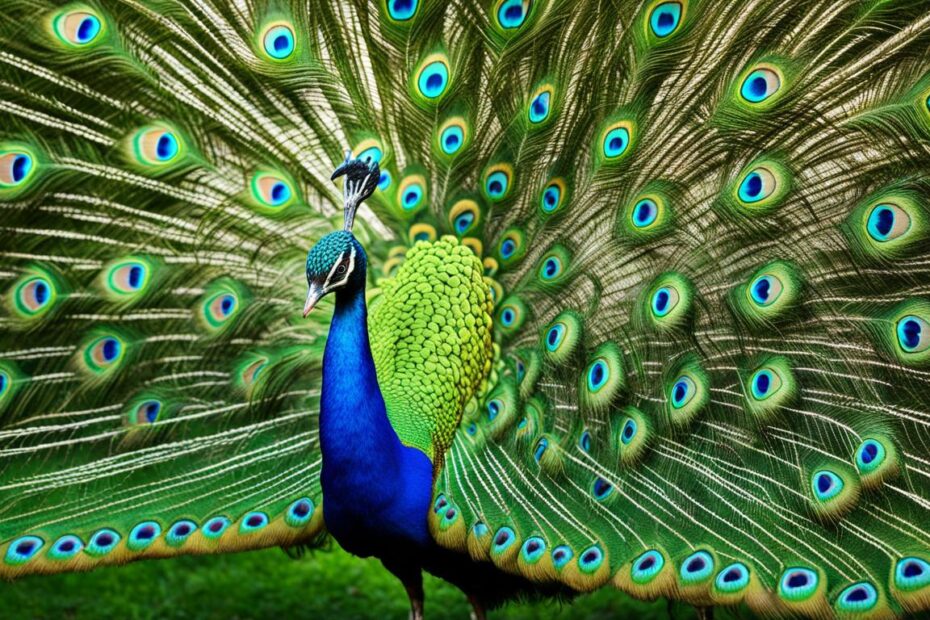Peacocks are known for their stunning plumage, but did you know they also make unique and captivating sounds? From high-pitched cries to honks and screams, peacocks use a range of vocalizations to communicate with each other. In this article, we will delve into the world of peacock vocalizations and explore the different sounds they make, as well as the reasons behind their noisy behavior.
Key Takeaways:
- Peacocks make various vocalizations, including cries, honks, and screams.
- They use these sounds to communicate with other peafowls and attract mates.
- Peacock vocalizations are particularly loud during the mating season.
- Peahens also make sounds to communicate and respond to peacock displays.
- Controlling peacock noise can be challenging, but efforts can be made to manage it.
Why Do Peacocks Make Noise?
Peacocks are known for their elaborate displays of colorful feathers, but they are equally famous for the noises they make. Understanding why peacocks make noise can provide insights into their behavior and communication patterns.
One of the primary reasons peacocks make noise is to communicate with other peafowls. They use a variety of vocalizations to greet each other, alert each other of potential danger, and attract mates during the mating season. These vocalizations play a crucial role in establishing and maintaining social bonds among peafowls.
Peacocks may also make noise to assert dominance and establish their territory. Males will often produce loud calls and displays to intimidate rival males and signal their presence to other peafowls in the area. These territorial vocalizations help maintain hierarchical structures within peacock populations.
| Noise Purpose | Description |
|---|---|
| Communication | Greeting, alerting of danger, attracting mates |
| Territorial Assertion | Signaling presence, establishing dominance |
Peacocks use vocalizations as a means of communication, expressing their presence and emotions to other peafowls. These sounds serve essential functions in their social interactions and are an integral part of their behavior.
In conclusion, peacocks make noise both to communicate and establish dominance. Their vocalizations serve as a means of greeting, alerting, and attracting mates. Understanding the reasons behind peacock vocalizations provides valuable insights into their behavior and social dynamics.
What Noises Do Peacocks Make?
Peacocks are not only known for their stunning plumage but also for the variety of noises they make. These vocalizations play a crucial role in their communication and behavior. From high-pitched cries to honks and screams, peacocks have a unique repertoire of sounds that they use in different situations.
When a peacock enters a new area, it may emit a screeching sound to announce its presence. This loud and distinctive noise serves as a way of signaling to other peafowls that it has arrived. During the mating season, peacocks make a series of honking and screaming noises, often accompanied by puffing out their feathers in an elaborate display, to attract peahens.
Peacock cries can resemble a baby crying or a cat meowing shrilly. These sounds can be quite loud and can carry over long distances. The peacock’s vocalizations are not only for attracting mates but also for communication among peafowls. Peacocks may use different sounds to greet each other, alert each other of danger, or establish their territory and assert dominance over other males.
Overall, the noises that peacocks make are a fascinating aspect of their behavior. Their vocalizations serve various functions and contribute to the unique experience of living near these beautiful birds. The next section will explore in more detail the sounds that peacocks produce during their mating season, providing insights into their intriguing behavior.
Peacock Sounds During Mating Season
The mating season is a particularly vocal time for peacocks. During this period, which typically occurs from early spring to late summer, male peacocks use their vocalizations to attract the attention of female peahens. One of the most prominent sounds that peacocks make during the mating season is a loud and distinctive honk. This honking sound serves as a signal to potential mates, indicating the male’s presence and readiness to engage in courtship.
In addition to honking, peacocks also engage in intense screaming during the mating season. This high-pitched scream is a way for males to further establish their dominance and attract the attention of nearby females. The combination of honking and screaming creates a cacophony of sound that can be heard from a considerable distance, ensuring that the peacock’s mating call reaches as many peahens as possible.

Overall, peacock vocalizations during the mating season serve as a means of communication and courtship. By producing loud and distinct sounds, peacocks are able to attract potential mates and establish their dominance within their territory. These vocal displays are a fascinating part of peacock behavior and add to the overall spectacle of these magnificent birds during the mating season.
Peahen Vocalizations
While peacocks are known for their loud vocalizations, peahens also play a significant role in communication within the peafowl community. Peahens utilize a range of vocalizations to convey important messages and respond to the elaborate displays of peacocks during the mating season. These vocalizations allow peahens to assert their preferences and maintain social cohesion within the group.
The vocalizations of peahens are often high-pitched and can resemble chirps or trills. They use these sounds to signal their presence, communicate with other birds, and respond to the courtship displays of peacocks. Peahens may emit specific vocalizations to express interest or disinterest in a peacock’s display, thereby influencing the male’s behavior and potentially influencing the outcome of mating.
Peahen vocalizations are an essential part of the breeding process and help establish a hierarchy within the group. The chorus of vocalizations from both peafowls contributes to the overall dynamics of the peafowl community, ensuring effective communication and successful reproduction.
Table: Peacock Displays and Peahen Vocalizations
| Peacock Display | Peahen Vocalization |
|---|---|
| Feather Shaking | Chirping or Trilling |
| Train Rattle | Soft Purring or Cooing |
| Wing Flutter | Warbling or Whistling |
The table above provides a summary of the peacock displays and the corresponding peahen vocalizations. Each display by the male peacock elicits a specific response from the females, enabling them to communicate their interest or lack thereof. Together, the displays and vocalizations form a complex and fascinating courtship ritual that highlights the intricate social dynamics of peafowls.
Peacock Sounds in the Wild vs. in Captivity
When it comes to peacock sounds, there are notable differences between their vocalizations in the wild and in captivity. In the wild, peacocks can produce incredibly loud noises, especially when multiple peacocks and peahens are together. Their calls can reverberate through the surrounding area, creating a cacophony of sound that is both impressive and distinct. Peafowls use these vocalizations to communicate with each other and establish their presence in their natural habitat.
However, in captivity, such as in zoos or controlled environments, efforts are made to manage the noise level produced by peafowls. Zoos often limit the number of peacocks and peahens to reduce overall noise. Additionally, during the mating season, peacocks and peahens may be separated to minimize the noise generated by their vocal displays. These measures help ensure a more pleasant experience for visitors and neighboring areas, as the loudness of peacock vocalizations can be overwhelming in close quarters.
Nevertheless, even in suburban neighborhoods or farms where peafowls are present, the sound of peacock vocalizations can still be quite prominent. The unmistakable calls of peacocks can carry over long distances, adding a unique touch to the local soundscape. Despite efforts to control their noise levels, it’s important to remember that peacock sounds are a natural part of their behavior and cannot be completely suppressed.

Table: A Comparison of Peacock Sounds in the Wild and in Captivity
| Peacock Sounds in the Wild | Peacock Sounds in Captivity | |
|---|---|---|
| Noise Level | Can be incredibly loud, especially when multiple peafowls are present | Efforts are made to minimize noise levels for visitor and neighbor comfort |
| Communication | Used to establish presence, communicate with other peafowls | May be limited due to separated peafowls during mating season |
| Control Measures | N/A – Natural behavior | Limiting the number of peafowls, separating during mating season |
| Impact on Surrounding Area | Can be overpowering in the immediate vicinity | Efforts to minimize noise for visitor and neighbor comfort |
Living near peacocks can be a unique experience due to the constant noise they produce. While their vocalizations can be fascinating to observe, it’s also important to consider the potential impact on the surrounding environment and community. Efforts are being made to strike a balance between accommodating these beautiful birds and minimizing the disruptions caused by their vocal displays.
In conclusion, peacock sounds in the wild are often louder and more pronounced, reflecting their natural behavior and communication dynamics. In captivity, steps are taken to manage noise levels, but the distinct calls of peacocks can still be heard in suburban areas. By understanding and appreciating the unique soundscape that peacock vocalizations create, we can better coexist with these majestic birds.
Description of Peacock Sounds
Peacocks make a variety of sounds, each with its own distinct purpose and meaning. One of the most common sounds they make is a screeching call, which they use when entering a new area to announce their presence. This screeching sound is loud and piercing, often resembling the cry of a baby or the screech of a cat. It serves as a way for the peacock to establish itself and communicate with other peafowls in the vicinity.
Another sound that peacocks produce is a honking call. This call is usually associated with alarm or distress and is emitted when the peacock senses a potential threat nearby. The honking sound is deep and forceful, serving as a warning to other peafowls in the area. It is a clear indication that something may be amiss and prompts the peacocks to be on high alert.
During the mating season, peacocks showcase a range of vocalizations to attract peahens. These vocalizations include honking, screaming, and a unique train rattle created by quivering their tail feathers. The honking and screaming sounds are loud and intense, designed to grab the attention of female peafowls. The train rattle, on the other hand, is a soft rustling sound caused by the vibrations of the peacock’s magnificent tail feathers.
Table: Peacock Sound Descriptions
| Sound | Description |
|---|---|
| Screeching Call | A loud and piercing cry, resembling a baby’s cry or a cat’s screech, used to announce the peacock’s presence. |
| Honking Call | A deep and forceful sound emitted when the peacock senses danger, serving as an alarm call to other peafowls. |
| Mating Calls | Honking, screaming, and a unique train rattle produced during the mating season to attract peahens. |
Overall, the sounds that peacocks make are diverse and serve different purposes. From screeching calls to honking alarms and captivating mating calls, these vocalizations are an integral part of the peacock’s communication and behavior.
Peacock Sounds in Different Situations
Peacocks are known for their distinct vocalizations, which they use in various situations to communicate with their surroundings. Understanding the different sounds they make can provide insights into their behavior and interactions. Let’s take a closer look at the sounds peacocks produce in different situations:
Greetings
When peacocks encounter each other, they often greet one another with a unique screeching sound. This vocalization serves as a way for peacocks to establish a positive interaction and acknowledge each other’s presence. The screeching sound is distinct and can be heard from a distance, allowing the peacocks to greet and locate each other.
Alarms
Peacocks have a keen sense of awareness and use vocalizations to alert others in the vicinity of potential threats. When a peacock senses danger, it emits high-pitched screams as an alarm call. This sharp sound warns other peafowls and nearby animals of the presence of a predator, helping them stay vigilant and protect their territory.
Mating Displays
During the mating season, peacocks produce a range of sounds to attract peahens and establish dominance. They engage in elaborate displays, including tail feather quivering and emitting honking and screaming sounds. These distinctive vocalizations serve as an advertisement of their fitness and readiness to mate, capturing the attention of peahens and signaling their availability.
| Situation | Sound |
|---|---|
| Greetings | Screeching |
| Alarms | High-pitched screams |
| Mating Displays | Honking and screaming |
Peacocks are fascinating creatures that use their vocalizations to communicate and navigate different social situations. Whether it’s greeting, alarming, or attracting mates, the sounds they produce play a crucial role in their daily lives and interactions. Understanding these sounds allows us to appreciate the complexity of their behavior and the unique experiences they bring to their environment.
Controlling Peacock Noise
Minimizing peacock sounds can be a challenging task, as these birds have natural vocalizations that are an intrinsic part of their behavior. However, there are some strategies that can help manage peacock noise in certain settings.
To control peacock noise, limiting the number of peacocks and peahens in a group can be effective. By reducing the overall population, the amount of noise produced can be significantly decreased. Additionally, separating peacocks and peahens during the mating season in captivity can help manage noise levels, as the males are known to be particularly vocal during this time.
In suburban neighborhoods or farms where peafowls are present, efforts can be made to capture wild peacocks and transfer them to more contained areas away from residential locations. This can help mitigate noise-related issues and create a more peaceful environment for those living nearby. However, it’s important to note that in the wild, peafowls will continue to make loud sounds as part of their natural behavior.
| Strategies to Control Peacock Noise | Effectiveness |
|---|---|
| Limiting the number of peafowls in a group | Effective in reducing overall noise levels |
| Separating peacocks and peahens during mating season | Helps manage noise levels during peak vocalization periods |
| Transferring wild peacocks to contained areas away from residential locations | Can mitigate noise-related issues in suburban neighborhoods |
While efforts can be made to minimize peacock noise, it’s important to remember that these vocalizations are a natural aspect of their behavior. As such, complete control over peacock vocalizations may not be achievable in all situations.

Conclusion
Peacocks are truly remarkable creatures that captivate us not only with their stunning plumage but also with their distinctive vocalizations. Their sounds range from high-pitched cries to honks and screams, serving different purposes such as communication, territorial assertion, and mate attraction.
During the mating season, peacocks become particularly vocal, emitting loud honks and screams to capture the attention of peahens. These vocal displays, combined with their impressive train rattling, create a sensory spectacle that is both mesmerizing and unique.
While efforts can be made to minimize the noise levels of peacocks in captivity, it is important to recognize that their vocalizations are an integral part of their natural behavior. Peacock sounds, including their screeching calls and honking cries, contribute to their overall allure and cannot be completely controlled.
In conclusion, the sounds of peacocks provide us with an auditory experience unlike any other. Whether we encounter them in the wild or hear their calls in suburban neighborhoods, these vocalizations remind us of the remarkable diversity of the animal kingdom and the beauty of nature’s symphony.
FAQ
What kind of noise does a peacock make?
Peacocks make a variety of vocalizations, including high-pitched cries, screams, screeches, honks, and a unique train rattle created by quivering their tail feathers.
Why do peacocks make noise?
Peacocks make noise to communicate with other peafowls, greet each other, alert each other of danger, attract mates during the mating season, and establish their territory.
What noises do peacocks make?
Peacocks make high-pitched cries, screams, screeches, honks, and a unique train rattle sound when they quiver their tail feathers.
What sounds do peacocks make during the mating season?
During the mating season, peacocks make loud honking and screaming sounds to attract peahens.
Do peahens make sounds too?
Yes, peahens make high-pitched noises to alert other birds of predators and respond to a peacock’s display during the mating season.
How are peacock sounds different in the wild and in captivity?
Peacocks in the wild can be incredibly loud, especially when multiple peafowls are together. In captivity, efforts are made to manage noise levels by limiting the number of peafowls or separating them during the mating season.
How would you describe peacock sounds?
Peacock sounds can resemble a baby crying, a cat meowing shrilly, and a loud rustling sound created by quivering tail feathers.
In what situations do peacocks make specific sounds?
Peacocks make screeching sounds to announce their presence when entering a new area, emit high-pitched screams as alarm calls when they detect potential threats, and produce honking and screaming sounds during the mating season to attract peahens.
How can peacock noise be controlled?
Controlling peacock noise can be challenging, but efforts can be made by limiting the number of peafowls, separating them during the mating season in captivity, or capturing wild peacocks and transferring them to more contained areas away from residential areas.
What is it like living near peacocks?
Living near peacocks can be a unique experience due to the constant noise they produce. While it can be comical to describe the sounds as a cat meowing or a baby crying, the loudness can become overwhelming, especially for those living in close proximity to peacocks.


